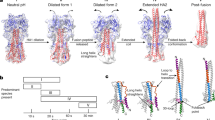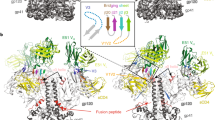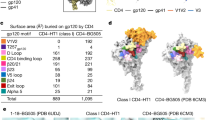Abstract
Fusion of viral and cellular membranes by the envelope glyco-protein gp120/gp41 effects entry of HIV-1 into the cell. The precursor, gp160, is cleaved post-translationally into gp120 and gp41 (refs 1,2), which remain non-covalently associated. Binding to both CD4 and a co-receptor leads to the conformational changes in gp120/gp41 needed for membrane fusion3. We used X-ray crystallography to determine the structure of the protease-resistant part4,5 of a gp41 ectodomain solubilized with a trimeric GCN4 coiled coil in place of the amino-terminal fusion peptide6. The core of the molecule is found to be an extended, triple-stranded a-helical coiled coil with the amino terminus at its tip. A carboxy-terminal α-helix packs in the reverse direction against the outside of the coiled coil, placing the amino and carboxy termini near each other at one end of the long rod. These features, and the existence of a similar reversal of chain direction in the fusion pH-induced conformation of influenza virus HA2 (ref. 7) and in the transmembrane subunit of Moloney murine leukaemia virus8 (Fig. la–d), suggest a common mechanism for initiating fusion.
This is a preview of subscription content, access via your institution
Access options
Subscribe to this journal
Receive 51 print issues and online access
$199.00 per year
only $3.90 per issue
Buy this article
- Purchase on Springer Link
- Instant access to full article PDF
Prices may be subject to local taxes which are calculated during checkout
Similar content being viewed by others
References
Allan, J. S. et al. Major glycoprotein antigens that induce antibodies in AIDS patients are encoded by HTLV-III. Science 228, 1091–1094 (1985).
Veronese, F. D. et al. Characterization of gp41 as the transmembrane protein coded by the HTLV-III/LAV envelope gene. Science 229, 1402–1405 (1985).
D'Souza, M. P. & Harden, V. A. Chemokines and HIV-1 second receptors: confluence of two fields generates optimism in AIDS research. Nat. Med. 2, 1293–1300 (1996).
Blacklow, S. C., Lu, M. & Kim, P. S. A trimeric subdomain of the simian immunodeficiency virus envelope glycoprotein. Biochemistry 34, 14955–14962 (1995).
Lu, M., Blacklow, S. C. & Kim, P. S. A trimeric structural domain of the HIV-1 transmembrane glycoprotein. Nature Struct. Biol. 2, 1075–1082 (1995).
Weissenhorn, W. et al. Assembly of a rod-shaped chimera of a trimeric GCN4 zipper and the HIV-1 Gp41 ectodomain expressed in E. coli. Proc. Natl Acad. Sci. USA (in the press).
Bullough, P. A., Hughson, F. M., Skehel, J. J. & Wiley, D. C. Structure of influenza haemagglutinin at the pH of membrane fusion. Nature 371, 37–43 (1994).
Fass, D., Harrison, S. C. & Kim, P. S. Retrovirus envelope domain at 1.7 Å resolution. Nature Struct. Biol. 3, 465–469 (1996).
Harbury, P. B., Kim, P. S. & Alber, T. Crystal structure of an isoleucine-zipper trimer. Nature 371, 80–83 (1994).
Chambers, P., Pringle, C. R. & Easton, A. J. Heptad repeat sequences are located adjacent to hydrophobic regions in several types of virus fusion glycoproteins. J. Gen. Virol. 71, 3075–3080 (1980).
Gallaher, W. R., Ball, J. M., Garry, R. F., Griffin, M. C. & Montelaro, R. C. A general model for the transmembrane proteins of HIV and other retroviruses. AIDS Res. Hum. Retroviruses 5, 431–440 (1989).
Weissenhorn, W. et al. The ectodomain of HIV-1 env subunit gp41 forms a soluble, alpha-helical, rod-like oligomer in the absence of gp120 and the N-terminal fusion peptide. EMBO J. 15, 1507–1514 (1996).
Crick, F. H. C. The Fourier transform of a coiled-coil. Acta Crystallogr. 6, 685 (1953).
Skehel, J. J. et al. Changes in the conformation of influenza virus haemagglutinin at the pH optimum of virus-mediated membrane fusion. Proc. Natl Acad. Sci. USA 79, 968–972 (1982).
Carr, C. M. & Kim, P. S. A spring-loaded mechanism for the conformational change of influenza hemagglutinin. Cell 73, 823–832 (1993).
Ruigrok, R. W. et al. Studies on the structure of the influenza virus haemagglutinin at the pH of membrane fusion. J. Gen. Virol. 69, 2785–2795 (1988).
Wharton, S. A. et al. Electron microscopy of antibody complexes of influenza virus haemagglutinin in the fusion pH conformation. EMBO J. 14, 240–246 (1995).
Moore, J. P., McKeating, J. A., Weiss, R. A. & Sattentau, Q. J. Dissociation of gp120 from HIV-1 virions induced by souble CD4. Science 250, 1139–1142 (1990).
Hart, T. K. et al. binding of soluble CD4 proteins to human immunodeficiency virus typel and infected cells induces release of envelope glycoprotein gp120. Proc. Natl Acad. Sci. USA 88, 2189–2193 (1991).
Kirsh, R. et al. Morphometic analysis of recombinant soluble CD4-mediated release of the envelope glycoprotein gp120 from HIV-1. AIDS Res. Hum. Retroviruses 6, 1209–1212 (1990).
Chen, J. et al. A soluble domain of the membrane-anchoring chain of influenza virus hemagglutinin (HA2) folds in Escherichia coli into the low-pH-induced conformation. Proc. Natl Acad. Sci. USA 92, 12205–12209 (1995).
Wild, C. T., Oas, T., McDanal, C. B., Bolognesi, D. & Matthews, T. A synthetic inhibitor of human immunodeficiency virus replciation: Correlation between solution structure and viral inhibition. Proc. Natl Acad. Sci. USA 89, 10537–10541 (1992).
Wild, C. T., Shugars, D. C., Greenwell, T. K., McDanal, C. B. & Matthews, T. J. Peptides corresponding to a predictive alpha-helical domain of human immunodeficiency virus type 1 and gp41 are potent inhibitors of virus infection. Proc. Natl Acad. Sci. USA 91, 9770–9774 (1994).
Chen, C. H., Matthews, T. J., McDanal, C. B., Bolognesi, D. P. & Greenberg, M. L. A molecular clasp in the human immunodeficiency virus (HIV) type 1 TM protein determines the anti-HIV activity of gp41 derivatives: implication for viral fusion. J. Virol. 69, 3771–3777 (1995).
Dubay, J. W., Roberts, S. J., Brody, B. & Hunter, E. Mutations in the leucine zipper of the human immunodeficiency virus type 1 transmembrane glycoprotein affect fusion and infectivity. J. Virol. 66, 4748–4756 (1992).
Skehel, J. J. et al. Membrane Fusion by Influenza Hemagglutinin. Cold Spring Harb. Symp. Quant. Biol. 60, 573–580 (1996).
Rey, F. A., Heinz, F. X., Mandl, C., Kunz, C. & Harrison, S. C. The envelope glycoprotein from tick-borne encephalitis virus at 2 Å resolution. Nature 375, 291–298 (1995).
Leikin, S., Parsegian, V. A., Rau, D. C. & Rand, R. P. Hydration forces. Annu. Rev. Phys. Chem. 44, 369–395 (1993).
Danieli, T., Pelletier, S. L., Henis, Y. I. & White, J. M. Membrane fusion mediated by the influenza virus hemagglutinin requires the concerted action of at least three hemagglutinin trimers. J. Cell Biol. 133, 559–569 (1996).
Kanaseki, T., Kawasaki, K., Murata, M., Ikeuchi, Y. & Ohnishi, S.-I. Structural features of membrane fusion between influenza virus and liposome as revealed by quick-freezing electron microscopy. J. Cell Biol. (in the press).
Chan, D. C., Pass, D., Berger, J. M. & Kim, P. S. Core structure of gp41 from the HIV envelope glycoprotein. Cell 89, 263–273 (1997).
CCP4 The CCP4 Suite: Programs for Protein Crystallography. Acta Crystallogr. D 50, 760–776 (1994).
Brünger, A. T. X-PLOR (Version 3.1) Manual (Yale University, New Haven, CT, 1992).
Myers, G. et al. in Theoretical Biology and Biophysics Group, Los Alamos (National Library, Los Alamos, NM, 1995).
Kraulis, P. MOLSCRIPT: a program to produce both detailed and schematic plots of protein structures. J. Appl. Crystallogr. 24, 924–950 (1991).
Author information
Authors and Affiliations
Rights and permissions
About this article
Cite this article
Weissenhorn, W., Dessen, A., Harrison, S. et al. Atomic structure of the ectodomain from HIV-1 gp41. Nature 387, 426–430 (1997). https://doi.org/10.1038/387426a0
Received:
Accepted:
Issue Date:
DOI: https://doi.org/10.1038/387426a0
This article is cited by
-
A stapled lipopeptide platform for preventing and treating highly pathogenic viruses of pandemic potential
Nature Communications (2024)
-
Extreme parsimony in ATP consumption by 20S complexes in the global disassembly of single SNARE complexes
Nature Communications (2021)
-
Conformational plasticity underlies membrane fusion induced by an HIV sequence juxtaposed to the lipid envelope
Scientific Reports (2021)
-
Identification of the natural product berberine as an antiviral drug
AMB Express (2020)
-
Structural basis of transmembrane coupling of the HIV-1 envelope glycoprotein
Nature Communications (2020)
Comments
By submitting a comment you agree to abide by our Terms and Community Guidelines. If you find something abusive or that does not comply with our terms or guidelines please flag it as inappropriate.



